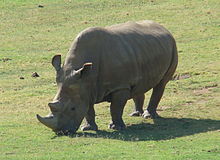Ceratotherium simum cottoni
| Northern white rhinoceros | |
|---|---|
 |
|
| Angalifu, a male northern white rhinoceros at the San Diego Zoo Safari Park. Angalifu died 14 December 2014 | |
| Scientific classification | |
| Kingdom: | Animalia |
| Phylum: | Chordata |
| Class: | Mammalia |
| Order: | Perissodactyla |
| Family: | Rhinocerotidae |
| Genus: | Ceratotherium |
| Species: | C. simum |
| Subspecies: | C. s. cottoni |
| Trinomial name | |
|
Ceratotherium simum cottoni (Lydekker, 1908) |
|
 |
|
| Orange = Northern white rhino range, Green = Southern white rhino range | |
The northern white rhinoceros, or northern square-lipped rhinoceros (Ceratotherium simum cottoni), is one of the two subspecies of the white rhinoceros. Formerly found in several countries in East and Central Africa south of the Sahara, it is listed as Critically Endangered. This subspecies is a grazer in grasslands and savanna woodlands. As of November 2015[update], there are only three rhinos of this subspecies left. They all belong to the Dvůr Králové Zoo in the Czech Republic but live in the Ol Pejeta Conservancy in Kenya and are protected round-the-clock by armed guards. According to the latest IUCN's assessment from 2011, the subspecies is considered "Critically Endangered (Possibly Extinct in the Wild)".
The zoo population is declining, and northern whites have rarely reproduced in captivity. There are now only three northern white rhinos left. They all belong to the Dvůr Králové Zoo in the Czech Republic, but were transported to Ol Pejeta Conservancy in Kenya, Africa. They arrived at the conservancy after an air and road trip on 20 December 2009.
The three rhinos (1 male and 2 female), under constant watch by specialists and staff, lived in specially constructed bomas with access to a 400×400-metre paddock area, allowing them to acclimatize to their new surroundings. These three were:
To prevent any unnecessary injuries they might inflict on each other while interacting in their fenced area, and give their horns an opportunity to regrow to a natural shape (as their front horns had grown bent by much rubbing against enclosure bars in captivity), all three rhinos were sedated and their horns were sawn off. This also made them less vulnerable to the poaching that drove their species to near extinction, as the horn is what the poachers are after. In place of their horns, radio transmitters have been installed to allow closer monitoring of their whereabouts. They are protected round-the-clock by armed guards.
...
Wikipedia

